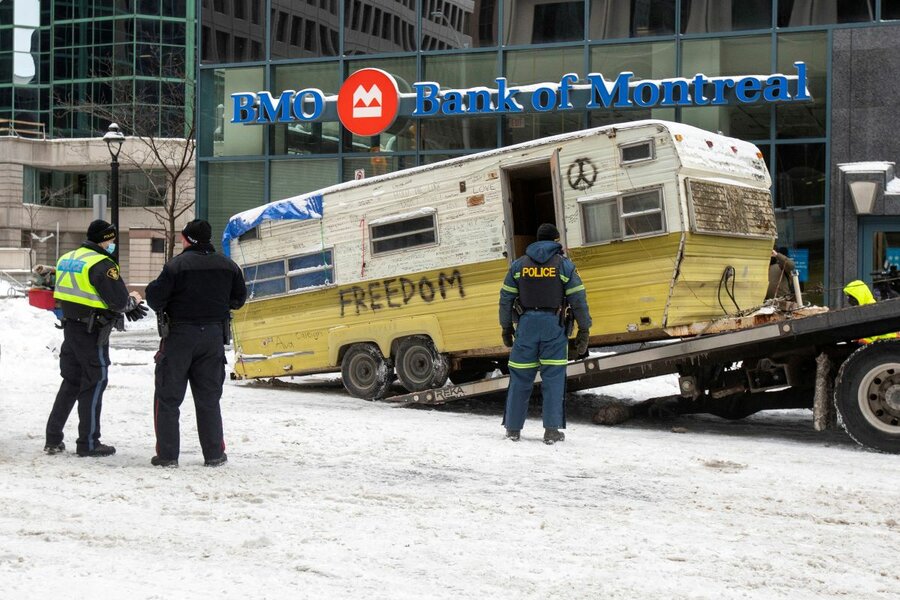
Toronto
The streets around the Canadian Parliament are quiet now. The Ottawa protesters who vowed never to give up are largely gone, chased away by policemen in riot gear. The relentless blare of truckers’ horns has gone silent.
But the trucker protest, which grew until it closed a handful of Canada-U.S. border posts and shut down key parts of the capital city for weeks, could echo for years in Canadian politics and perhaps south of the border.
The protest, which was first aimed at a COVID-19 vaccine mandate for cross-border truckers but also encompassed fury over the range of COVID-19 restrictions and hatred of Prime Minister Justin Trudeau, reflected the spread of disinformation in Canada and simmering populist and right-wing anger.
“I think we’ve started something here,” said Mark Suitor, a protester from Hamilton, Ontario, speaking as police retook control of the streets around Parliament. Protesters had essentially occupied those streets for more than three weeks, embarrassing Trudeau and energizing Canada’s far right. Suitor believes the protests will divide the country, something he welcomes.
“This is going to be a very big division in our country,” he said. “I don’t believe this is the end.”
While most analysts doubt the protests will mark a historic watershed in Canadian politics, it has shaken both of Canada’s two major parties.
“The protest has given both the Liberals and the Conservatives a black eye,” said Nelson Wiseman, a political science professor at the University of Toronto. Trudeau’s Liberals look bad for allowing protesters to foments weeks of chaos in the capital city, he said, while the Conservatives look bad for championing protesters, many of them from the farthest fringes of the right.
The conservatives “have to be careful not to alienate more moderate voters, who are generally not sympathetic to the protesters or right-wing populism more generally,” said Daniel Béland, a political science professor at McGill University in Montreal.
The self-styled Freedom Convoy shook Canada’s reputation for civility, inspired convoys in France, New Zealand, and the Netherlands and interrupted trade, causing economic damage on both sides of the border. Hundreds of trucks eventually occupied the streets around Parliament, a display that was part protest and part carnival.
Authorities moved quickly to reopen the border posts, but police in Ottawa did little but issue warnings until the past couple days, even as hundreds and sometimes thousands of protesters clogged the streets of the city and besieged Parliament Hill.
Truckers ignored warnings that they were risking arrest and could have their rigs seized and bank accounts frozen under the new emergency powers invoked by Mr. Trudeau. The truckers, parked on the streets in and around Parliament, blared their horns in defiance of a court injunction against honking, issued after residents said the constant noise was making the neighborhood unlivable.
“It’s high time that these illegal and dangerous activities stop,” Mr. Trudeau declared in Parliament a few days ago, speaking just a few hundred meters from the protests.
On Friday, authorities launched the largest police operation in Canadian history, arresting a string of Ottawa protesters and increasing that pressure on Saturday until the streets in front of Parliament were clear. Eventually, police arrested at least 191 people and towed away 57 vehicles. Many protesters retreated as the pressure increased.
The Ottawa protests – the movement’s last major stronghold – appeared to be largely over by Sunday morning. Fencing and police checkpoints remained.
As it did in the United States, COVID-19 quickly became a political issue in Canada.
Coronavirus health restrictions became a political cudgel for Canada’s far right, which accused Mr. Trudeau of authoritarianism. But while the restrictions clearly benefited the far-right People’s Party of Canada, things are more complicated in the Conservative Party.
Only recently have some Conservative leaders fully embraced the pushback against vaccine mandates and coronavirus restrictions.
Even so, the protests may open the door to the sort of populism that former President Donald Trump used to vault himself into the White House.
Pierre Poilievre, who is running to become the next leader of the Conservative party, has cheered on the protesters, gambling that voters will back him. But it remains unclear whether that will get him to the top of the party, or whether it would help or hurt him if there is a showdown between him and Mr. Trudeau or the next Liberal party leader.
“Poilievre is clearly playing by the populist playbook right now,” said Dr. Béland. “If he becomes Conservative leader, the party might effectively shift towards Trump-style populism. However, it’s unclear whether enough Canadians support this vision to make it appealing beyond the party’s base.”
The protests have been cheered on in the U.S. by Fox News personalities and conservatives like Mr. Trump. Millions of dollars in donations have flowed across the border to the protesters.
About 44% of the nearly $10 million in contributions to support the protesters originated from U.S. donors, according to an Associated Press analysis of leaked donor files. Prominent Republican politicians have praised the protesters.
But experts say the U.S. support of the Canadian protesters is really aimed at energizing conservative politics in the U.S., where midterm elections are looming.
And some in the United States have pushed back.
“When I say democracy is fragile I mean it,” Bruce Heyman, a U.S. ambassador to Canada during the Obama Administration. “Stand up for our friend Canada and let your voice be heard.”
Meanwhile, though the situation in Ottawa appeared to be ending, there were new signs the protests had not died out entirely.
The Canadian border agency warned late Saturday afternoon that operations at a key truck crossing from western Canada into the United States had been slowed by protesters, advising travelers to find a different route.